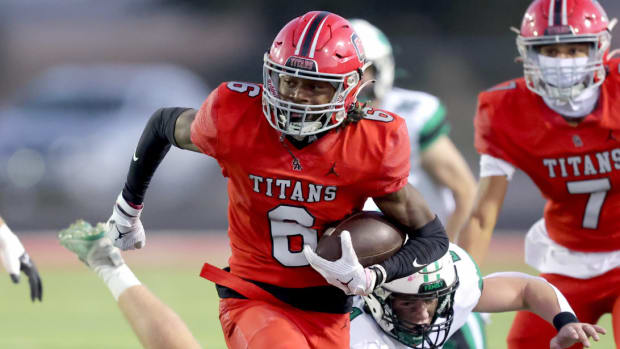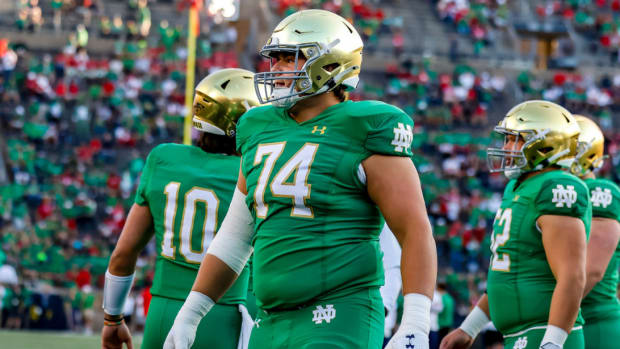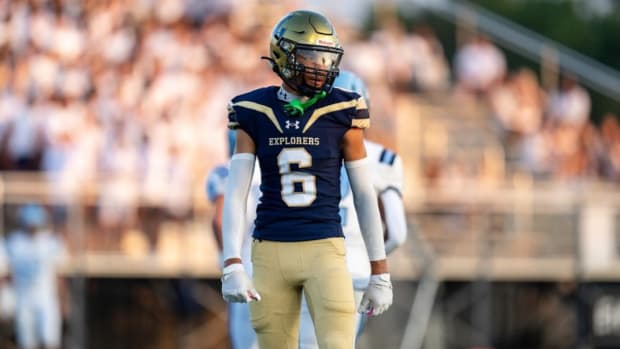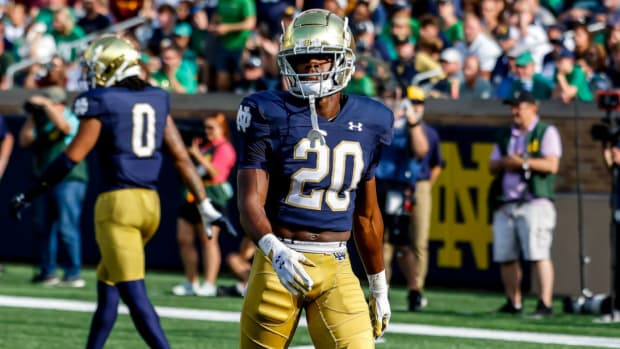Evaluating Ian Book's 2019 Campaign Is Not Easy
I am not sure in my 10 years of covering Notre Dame, or in my 30-plus years following Notre Dame that I’ve ever seen a quarterback draw such a dramatic difference of opinion from fans than Ian Book has this season.
The only quarterback that comes close is Jimmy Clausen.
Some view his season as being in the same category as other top quarterbacks. I saw a tweet yesterday that a stat from Book and compared it to players like Jalen Hurts (Oklahoma) and Trevor Lawrence (Clemson).
Others are ready for the Book era to be over.
So how should we evaluate Book’s senior season? Just how good was he this fall? That requires a lot of data, a lot of analysis and an open mind. I think the answer is that he played well at times, he didn’t play well at other times, and overall he had a quality campaign.
Let’s begin by taking a big picture look at Book’s season. (all-time refers to Notre Dame records)
220 completions - 8th most all-time
371 attempts - 8th most all-time
59.3% completion rate
2,787 passing yards - 10th most all-time
516 rushing yards - 6th most all-time
33 passing touchdowns - 2nd most all-time
4 rushing touchdowns
37 total touchdowns - 2nd most all-time
6 interceptions
148.52 pass efficiency rating
Book ranks fifth nationally in touchdown passes, 18th in total offense (passing plus rushing yards), 28th in total offense per game and 36th in passer rating.
From a big picture standpoint there was a lot to be pleased about with Book’s season, especially in the month of November, when he accounted for an average of 322 yards per game (passing and rushing) and accounted for 19 touchdowns in just five games.
DEEP BALL IMPROVEMENT
One of the criticisms I had of Ian Book in 2018 was his inability and unwillingness to attack downfield. Last fall, Book completed just 20 of his 49 attempts that went at least 20 yards down the field, according to Pro Football Focus. Book had 602 yards, five touchdowns and three interceptions with a 165.44 passer rating on those throws.
He made dramatic improvement as a senior, and in November his volume increased as well, which was a criticism I had of him in September and much of October. Book completed 30 of his 59 attempts that went at least 20 yards down the field. Those 30 completions went for 895 yards and he had nine touchdowns and just three interceptions to go with a 218.44 passer rating.
That is a dramatic leap in downfield production.
The reason Book’s completion percentage was so much lower than last season despite a big jump in deep ball success is that he saw at least a 5-percent drop in every other category.
Intermediate (10-19) - 48.4-percent in 2019, 61.4-percent in 2018
Short Throws (1-9) - 72.2-percent in 2019, 77.5-percent in 2018
Behind The Line - 78.9-percent in 2019, 92.9-percent in 2018
Part of those results is that PFF credits the 2019 skill players with 27 drops while the 2018 offense dropped just 13 of Book’s passes.
MORE RUN GAME IMPACT
Book was a bigger factor with his legs this season as well. His raw numbers show a dramatic jump in production, with Book rushing for 516 yards and four touchdowns. Last season he had 280 rushing yards and four touchdowns, but Book started just nine games in 2018. His yards per game average (43.0) was also up in 2019 compared to last season (30.8).
The jump in yards per rush (4.91 to 2.94) really shows the impact Book had with his legs this season. He had his first 100-yard game during the team’s 38-7 road victory over Duke, finishing with 139 yards in the game. He had four games with at least 50 rushing yards.
According to PFF, Book had 589 rushing yards if you remove sacks. He had 351 yards on scrambles and 238 yards on designed runs. He averaged 6.1 yards per rush on those non-sack attempts. That’s up from 4.3 in 2018.
DROP OFF
There were areas where Book’s game regressed this season as well. After completing 68.2-percent of his throws last season, Book completed just 59.3-percent of his throws in 2019. That resulted in a less efficient pass game, which is why his yards per attempt numbers is down to 7.5 after being 8.4 last fall.
His total yards per game (in starts only) is down from 322.0 in 2018 to 275.3 in 2018. His yards per play (throws, runs, sacks) is at 6.94, which is down from 7.15 last season. If you remove sacks, Book’s yards per play average is down to 7.22 from 7.55.
BIG GAME WOES
There are really two ways to evaluate a Notre Dame quarterback. One is statistically, and in that regard Book had an outstanding season.
The other is to evaluate how a quarterback performed against the best competition on the schedule. Being the quarterback at Notre Dame isn’t as much about putting up numbers as it is winning games. Being the quarterback at Notre Dame isn’t about how you perform against the worst teams on your schedule, it’s how you perform against the best teams you face.
That is where Book’s season deserves criticism. His numbers were incredibly inflated by dominance against inferior opponents. He struggled against the two best teams on the schedule (Georgia, Michigan), and his numbers against Power 5 opponents is subpar. His production against top Power 5 defenses was even worse.
Here are the numbers:
The numbers speak for themselves in so many ways. For context, Book’s 123.94 passer rating against Power 5 opponents would rank him 90th in the country. The 110.33 passer rating wouldn’t even be in the Top 100 nationally.
His passer rating against teams with a winning record 81st, and the winning record without the Michigan numbers (removed due to weather) would rank him 64th in the country.
Book’s numbers were excellent against teams that had a .500 record or worse. Twenty-one of his 33 touchdowns came in those games. Book had 12 touchdowns and six interceptions against teams with a winning record, and five of those touchdowns came against Navy. Navy’s pass defense ranks 79th in the country and 74th in pass efficiency defense.
Many seem willing to gloss over these numbers, including Notre Dame’s head coach. Kelly claims that good journalists should remove emotion from their analysis and stick with facts, stick with data. That’s good advice for coaches as well. The facts are what they are, and the facts are Notre Dame’s offense - and its quarterback - aren’t very good against the top teams on the schedule.
Notre Dame averaged just 24 points per game against those Top 50 defenses it faced, and its yards per play average was just 5.3 yards per play. The Irish averaged just 22.3 points per game, 324.0 yards per game and 4.9 yards per play against the four Power 5 opponents that are currently ranked in the Top 25. It averaged just 15.5 points against the two Top 20 teams it faced.
Yes, I realize I left Navy out of the mix, and there’s a good reason. Notre Dame as a team, and Notre Dame’s quarterback, should not be judged by what they do against Navy. This is a program that is certainly better than it was when Notre Dame went four decades without losing to the Midshipmen, but it’s still a program Notre Dame should beat every single year.
Notre Dame as a program should be evaluated on its ability to play for championships, and its quarterback should be evaluated at the same standard. Simply put, Book has played against three Top 20 teams during his 21 starts, and he struggled in all three games. Book has three touchdowns and three interceptions in those games, and the Irish offense averaged just 11.3 points per game.
Many Notre Dame fans liked to harp on how poor of a passer Brandon Wimbush was during his career. When you look at how Wimbush faced against Top 50 defenses and how Book played this season against Top 50 defenses some interesting numbers emerge.
Wimbush faced seven Top 50 defenses in 2017 while Book faced five this fall. As you can see, Book barely had a better completion percentage while Wimbush had a better yards per attempt average and a higher passer rating.
Notre Dame’s offense averaged more points (33.1 to 24.0), yards (445.9 to 377.0) and yards per play (6.19 to 5.15) in 2017 compared to 2019.
Now this is not to revisit the Wimbush vs. Book debate. I’m on record as saying I understand that move, and we saw last season the spark it gave the offense.
This is an attempt, however, to point out that Wimbush was judged because of his failure against Miami (41-8 loss) and Stanford (38-20 loss), and the team’s loss to Georgia (20-19), as he should have been. His wins over ranked opponents Michigan, Michigan State, USC and NC State are ignored, and the losses in the “big games” are the focus. His lack of production in those losses is also the focus. That’s how it should be for a Notre Dame quarterback.
Book should be held to the same standard. We can praise him for the overall success he had, and enjoy watching him shred some defenses, while also demanding that he perform better against quality opponents. Book, like Wimbush and every quarterback before him, should be judged on how he performs in the bigger games, and the games played on the biggest stages.
Wimbush didn’t play well enough in those games and he lost his job for it, rightfully so. Book, however, is as a secure in his starting spot as any quarterback in the Brian Kelly era. We'll save that conversation for another day.
But what that means is Book needs to step up and play much, much better in the games that matter most if the Irish are going to take the next step as a program and that is something he did not do in 2019.
Follow me on Twitter: @CoachD178
Visit our Facebook page at: https://www.facebook.com/IrishMaven/






